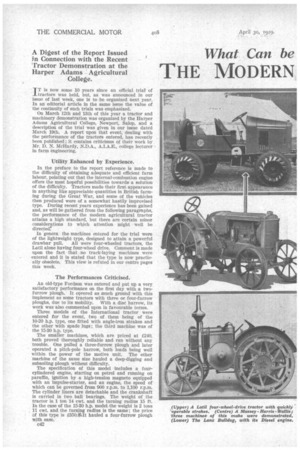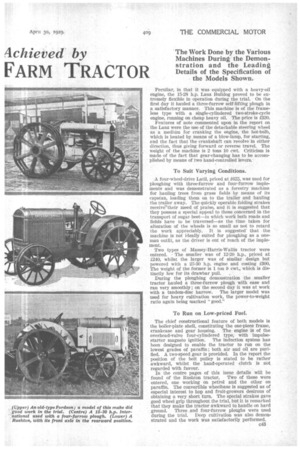What Can be Achieved by
Page 72

Page 73

If you've noticed an error in this article please click here to report it so we can fix it.
THE MODERN FARM TRACTOR
IT is now some 10 years since an official trial of tractors was held, but, as was announced in our issue of last week, one is to be organized next year. In an editorial article in the same issue the value of the continuity of such trials was emphasized.
On March 12th and 13th of this year a tractor and machinery demonstration was organized by the Harper Adams Agricultural College, Newport, Salop, and a description of the trial was given in our issue dated March 19th. A report upon that event, dealing with the performance of the tractors entered, has recently been published ; it contains criticisms of their work by Mr. D. N. McHardy, N.D.A., A.I.A.E., college lecturer in farm engineering.
Utility Enhanced by Experience.
In the preface to the report reference is made to the difficulty of obtaining adequate and efficient farm labour, pointing out that the internal-combustion engine offers the most hopeful possibilities towards a solution of the difficulty. Tractors made their first appearance in anything like appreciable quantities in British farming during the Great War, and some of the vehicles then produced were of a somewhat hastily improvised type. During recent years experience has been gained and, as will be gathered from the following paragraphs, the performance of the modern agricultural tractor attains a high standard, but there are certain minor considerations to which attention might well be directed'?
In genera the machines entered for the trial were of the lightweight type, designed to attain a powerful drawbar pull. All were four-wheeled tractors, the Lath l alone having four-wheel drive. Comment is made upon the fact that no track-laying machines were entered and it is stated that the type is now practically obsolete. This view is refuted in our centre pages this week.
The Performances Criticised.
An old-type Fordson was entered and put up a very satisfactory performance on the first day with a twofurrow plough. It covered as much ground with this implement as some tractors with three or four-furrow ploughs, due to its mobility. With a disc harrow, its work was also commented upon in favourable terms.
Three models of the International tractor were entered for the event, two of them being of the 10-20 h.p. type, one fitted with angle-iron strakes and the other with spade lugs; the third machine was of the 15-30 h.p. type.
The smaller machines, which are priced at 1240, both proved thoroughly reliable and ran without any trouble. One pulled a three-furrow plough and later operated a pitch-pole harrow, both loads being well within the power of the motive unit. The other machine of the same size hauled a deep-digging and subsoiling plough without difficulty.
The specification of this model includes a fourcylindered engine, starting on petrol and running on paraffin, ignition by a high-tension magneto equipped with an impulse-starter, and an engine, the speed of which can be governed from 900 r.p.m. to 1,100 r.p.m. The cylinder liners are detachable and the crankshaft is carried in two ball bearings. The weight of the tractor is 1 ton 14 cwt. and the turning radius 15 ft. In the case of the 15-30 h.p. model the weight is 2 tons 11 cwt. and the turning radius is the same; the price -a this type is £350OAIt hauled a four-furrow plough with ease.
c42 Peculiar, in that it was equipped with a heavy-oil engine, the 15-28 h.p. Lanz Bulldog proved to be extremely flexible in operation during the trial. On the first day it hauled a three-furrow self-lifting plough in a satisfactory manner. This machine is of the frameless type with a single-cylindered two-stroke-cycle engine, running on cheap heavy oil. The price is £320.
Features of note commented upon in the report on the Lanz were the use of the detachable steering wheel as a medium for cranking the engine, the hot-bulb, which is heated by means of a blow-lamp, for starting, and the fact that the crankshaft can revolve in either direction, thus giving forward or reverse travel. The weight of the machine is 2 tons 10 cwt. Criticism is made of the fact that gear-changing has to be accomplished by means of two hand-controlled levers.
To Suit Varying Conditions.
A four-wheel-drive Latil, priced at £62c5, was used for ploughing with three-furrow and four-furrow implements and was demonstrated as a forestry machine for hauling trees from grass fields by means of its capstan, loading them on to the trailer and hauling the trailer away. The quickly operable folding strakes receivetheir 'need of praise, and it is suggested that they possess a special appeal to those concerned in the transport of sugar beet—in which work both roads and fields have to be traversed—as the time taken for alteration of the wheels is so small as not to retard the work appreciably. It is suggested that the machine is not ideally suited for ploughing as a oneman outfit, as the driver is out of reach of the implement.
Two types of Massey-Harris-Wallis tractor were entered. The smaller was of 12-20 h.p., priced at £240, whilst the larger was of similar design but powered with a 25-30 h.p. engine and costing I300. The weight of the former is 1 ton 9 cwt., which is dis tinctly low for its drawbar pull. .
During the ploughing demonstration the smaller tractor hauled a three-furrow plough with ease and ran very smoothly ; on the second day it was at work with a tandem-disc harrow. The larger model was used for heavy cultivation work, the power-to-weight ratio again being marked good."
To Run on Low-priced Fuel.
The chief constructional feature of both models is the boiler-plate shell, constituting the one-piece frame, crankcase and gear housing. The engine is of the overhead-valve four-cylindered type, with impulsestarter magneto ignition. The induction system has been designed to enable the tractor to run on the lowest grades of paraffin ; both air and oil are purified. A two-speed gear is provided. In the report the position of the belt pulley is stated to be rather awkward, whilst the hand-operated clutch is not regarded with favour.
In the centre pages of this issue details will be found of the Rushton tractor. Two of these were entered, one working on petrol and the other on paraffin. The convertible wheelbase is suggested as of especial interest to hop and fruit-growers desirous of obtaining a very short turn. The special strakes gave good wheel grip throughout the trial, but it is remarked that they make the tractor awkward to handle on hard ground. Three and four-furrow ploughs were used during the trial. Deep cultivation was also demonstrated and the work was satisfactorily performed.




























































































































